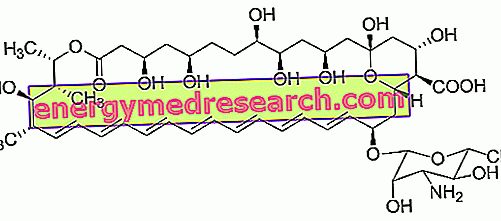Amphotericin B is an antifungal (or antifungal) drug first isolated from cultures of Streptomyces nodosus .
Amphotericin is a very effective drug, however it has a high toxicity, therefore, it must be used very carefully.

Amphotericin B - Chemical Structure
Indications
For what it uses
The use of amphotericin B is indicated for the treatment of serious fungal infections, such as:
- Candidiasis;
- Aspergillosis;
- Cryptococcosis (a pulmonary mycosis caused by Cryptococcus neoformans );
- Cryptococcal meningitis;
- Fusariosis (an infection caused by fungi of the genus Fusarium );
- Zygomycosis (an infection caused by some types of zygomycetes);
- Blastomycosis (a systemic mycosis caused by the fungus Blastomyces dermatitidis );
- Coccidioidomycosis (a systemic mycosis caused by Coccidioides immitis and Coccidioides posadasii ).
Warnings
Should any kind of allergic reaction occur during amphotericin B therapy, treatment with the antifungal must be stopped immediately and it is necessary to contact the doctor.
During treatment with amphotericin B, patients with pre-existing liver and / or kidney problems should undergo regular checkups.
Regular checks of serum electrolytes (especially potassium and magnesium) and of liver, kidney and hematopoietic function should be performed.
Amphotericin B can cause side effects that can alter the ability to drive and / or use machinery, so great care should be taken.
Interactions
Concomitant use of amphotericin B and other nephrotoxic drugs may increase the risk of developing renal toxicity.
Concomitant administration of amphotericin B and corticosteroids, corticotropin or diuretics may cause worsening of hypokalemia (lowering of blood levels of potassium) caused by the same amphotericin B.
Furthermore, hypokalaemia caused by amphotericin B can cause an increase in the toxicity induced by digitalis drugs, when administered simultaneously.
Concomitant intake of amphotericin B and musculoskeletal relaxants may potentiate the effect of the latter.
Concomitant administration of amphotericin B and flucytosine (another antifungal) can cause an increase in the toxicity of the latter.
Concomitant use of amphotericin B and anticancer drugs can cause an increase in renal toxicity and favor the appearance of bronchospasm and hypotension.
Finally, cases of acute pulmonary toxicity have been reported in patients receiving amphotericin B during, or immediately after, white blood cell transfusions .
In any case, it is always a good idea to inform your doctor if you are taking - or have recently been - any type of medication, including non-prescription medicines and herbal and / or homeopathic products.
Side effects
Amphotericin B can trigger various types of side effects, although not all patients experience them. This depends on the different sensitivity of each person towards the drug. Therefore, it is said that the undesirable effects do not occur all with the same intensity in each patient.
The main side effects that can occur during amphotericin B therapy are listed below.
Allergic reactions
Amphotericin B can cause allergic reactions in sensitive individuals. These reactions can occur in the form of:
- Breathing difficulties;
- Dizziness or fainting sensation;
- Intense skin itching;
- Urticaria;
- Angioedema.
Kidney and urinary tract disorders
Treatment with amphotericin B can cause:
- Increased blood levels of creatinine and urea;
- Acute renal failure;
- oliguria;
- Anuria;
- Renal tubular acidosis;
- nephrocalcinosis;
- Isosthenuria.
Alterations in the hemolymphopoietic system
Amphotericin B therapy can promote the onset of blood and lymphatic system disorders (the system responsible for the synthesis of blood cells). These alterations can cause:
- Piastrinopenia, ie the decrease in the number of platelets in the bloodstream;
- Leukopenia, ie the reduction in the number of leukocytes in the blood;
- Agranulocytosis, ie the decrease in the number of granulocytes in the bloodstream;
- Anemia.
Hepatobiliary disorders
Treatment with amphotericin B can cause changes in liver function, liver failure, hyperbilirubinemia and jaundice.
Cardiovascular disorders
Amphotericin B therapy can cause:
- Hypotension or hypertension;
- vasodilation;
- Redness;
- Tachycardia;
- arrhythmias;
- Cardiac arrest.
Lung and respiratory tract disorders
Dyspnea and bronchospasm may occur during treatment with amphotericin B.
Skin and subcutaneous tissue disorders
Amphotericin B therapy can promote the appearance of skin rashes.
Metabolism and nutrition disorders
During treatment with amphotericin B hypokalaemia, hyponatremia, hypomagnesaemia and hypocalcemia can occur (respectively, the reduction of blood levels of potassium, sodium, magnesium and calcium). Furthermore, hyperglycaemia may also occur.
Musculoskeletal disorders
Amphotericin B therapy can cause:
- Back pain;
- Bone pain;
- Joint pain;
- Rhabdomyolysis.
Gastrointestinal disorders
Treatment with amphotericin B can cause abdominal pain, nausea, vomiting and diarrhea.
Other side effects
Other side effects that may occur during treatment with amphotericin B are:
- Temperature;
- Chills;
- Tremors;
- Headache;
- Chest pain;
- Convulsions;
- Confusion;
- Weakness;
- Changes in vision;
- Peripheral neuropathy;
- Pain at the injection site.
Overdose
If you suspect an amphotericin B overdose, you must immediately inform your doctor. Treatment is supportive and the doctor may decide to monitor renal, hepatic, hematopoietic and cardiac function and to monitor respiratory rate and potassium levels in the body.
Action mechanism
Amphotericin B is a polyene antifungal that acts by altering the structure of the plasma membrane of fungi.
Like all polyene antifungals, amphotericin B has a high affinity for cell membranes containing sterols, in particular, for cell membranes that contain ergosterol (like those of fungi, in fact).
Amphotericin B is able to insert itself within the fungal cell membrane and increase its permeability.
The alteration of membrane permeability causes fungal cells to lose constituents that are essential to them (such as ions and small organic molecules), thus condemning them to certain death.
Mode of Use - Posology
Amphotericin B is available for intravenous administration.
The drug should only be administered by specialized medical personnel through an intravenous infusion.
The dose of drug usually administered is 5 mg / kg of body weight, to be administered through a single intravenous infusion.
Usually, treatment with amphotericin B lasts fourteen days.
Pregnancy and breastfeeding
Since there are insufficient data to establish the safe use of amphotericin B in pregnant women and breastfeeding mothers, the use of the drug in this category of patients should only be made if the potential benefits expected for the mother outweigh the potential risks to the fetus or newborn.
In any case, pregnant women and mothers who are breast-feeding should always seek medical advice before taking any type of medication.
Contraindications
The use of amphotericin B is contraindicated in patients with known hypersensitivity to amphotericin B.



